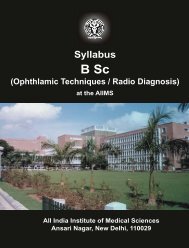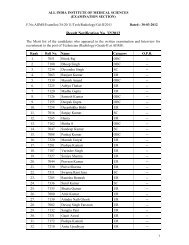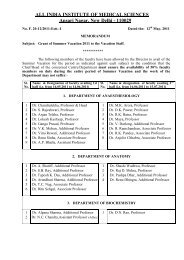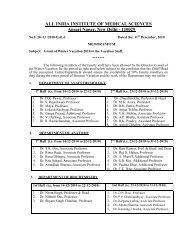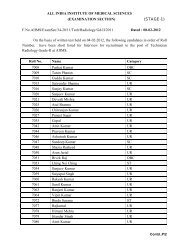Manual for long-term pharmacotherapy - All India Institute of Medical ...
Manual for long-term pharmacotherapy - All India Institute of Medical ...
Manual for long-term pharmacotherapy - All India Institute of Medical ...
Create successful ePaper yourself
Turn your PDF publications into a flip-book with our unique Google optimized e-Paper software.
Involuntary <strong>term</strong>ination <strong>of</strong> treatment<br />
At the beginning <strong>of</strong> treatment, patients should be in<strong>for</strong>med about the conditions in which the treatment may<br />
be temporarily suspended or <strong>term</strong>inated. These may include violence or threat <strong>of</strong> violence against staff or<br />
other patients, property damage or theft from the service centre, drug dealing on or near the service premises,<br />
diversion <strong>of</strong> medication and unacceptable disruption in the locality. If the patient is to be involuntarily<br />
withdrawn from buprenorphine treatment, reduction in dosage should be gradual. Rapid dose reduction or<br />
abrupt cessation <strong>of</strong> treatment is warranted only in cases <strong>of</strong> violence, assault or threatened assault. In general,<br />
involuntary withdrawal from buprenorphine should not take less than 14 days. The patient should be advised<br />
regarding other treatment options, including detoxification. He should also be warned <strong>of</strong> the increased risk <strong>of</strong><br />
overdose after completion <strong>of</strong> withdrawal. A plan <strong>for</strong> subsequent readmission into treatment <strong>for</strong> each patient<br />
involuntarily withdrawn from the programme should be made and documented in the patient's case record.<br />
Transfer to Naltrexone<br />
Naltrexone has the potential to assist people to remain abstinent from opioids after withdrawal from<br />
buprenorphine. The clinical experience from NDDTC, AIIMS has shown that some patients who were<br />
stabilised on buprenorphine maintenance could be shifted to naltrexone after tapering maintenance<br />
treatment.<br />
Maintenance Buprenorphine<br />
�Treatment duration-At least six months<br />
�Flexible dose<br />
�Other modalities <strong>of</strong> intervention<br />
Summary and Conclusions<br />
Opioid dependence is a relapsing disorder. Agonist maintenance treatment is associated with reduced drug<br />
use, improved psychosocial functioning, reduced risk <strong>of</strong> transmission <strong>of</strong> blood borne infections such as HIV<br />
and reduced mortality. Buprenorphine as an agonist maintenance agent is an important treatment option to<br />
treat opioid dependence. It is a safe compound, well tolerated by patients with significantly lower risk <strong>of</strong><br />
respiratory depression as compared with other opioids such as methadone. Data from clinical trials generally<br />
indicate that buprenorphine has comparable efficacy to moderate doses <strong>of</strong> methadone. The feasibility and<br />
effectiveness <strong>of</strong> buprenorphine maintenance in <strong>India</strong>n setting has been documented. Dosages prescribed in<br />
<strong>India</strong>n patients have been in the range <strong>of</strong> 4 mg to 8mg per day. These have been found effective and need to be<br />
used <strong>for</strong> an adequate duration.<br />
32




